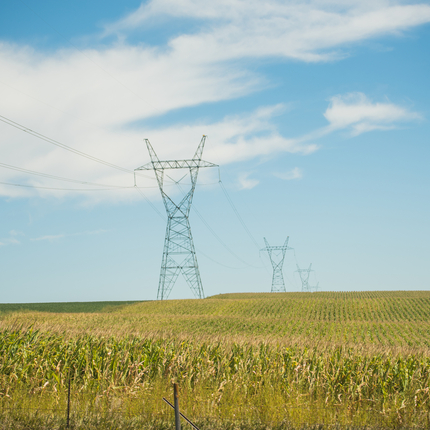As demand for reliable electricity grows, improving the resilience and adaptability of energy systems becomes increasingly crucial.
In Nebraska, an increase in frequent severe weather events, including storms, high temperatures, and greater weather variability, has tested the public utilities working to maintain reliable and resilient service for their customers.
In late July, a storm in southeast Nebraska left thousands without power, causing the largest simultaneous outage in the history of the Omaha Public Power District (OPPD). At the peak, there were about 221,000 customers without power, breaking the utility’s record of 188,000 set in 2021.
In a conversation with the Center for Rural Affairs, Eric Williams, a member of the OPPD Board of Directors, shared some of the key challenges the utility has dealt with in the past two years alone.
“We saw record-low water levels in the Missouri River, which led to ice forming on dam intake structures,” Eric said, recalling the winter of December 2022. “That caused serious issues for electric generation resources at both the North Omaha Station and the Nebraska City Station.”
Just two years later, OPPD faced the opposite issue.
“In 2024, we had high-water events, showing that these weather extremes are happening almost yearly now, and it can really strain our system,” Eric pointed out.
The fluctuating water levels have disrupted service, requiring OPPD to adopt new ways to manage peak energy demand, especially with urban growth and more frequent heat waves adding to the pressure.
Additionally, Eric said that OPPD has faced resource adequacy challenges to ensure there is enough electricity to meet customer demand.
“We’ve had to issue conservation notices asking customers to cut back on electricity during high demand times,” Eric said. “During severe winter events in 2021, [OPPD] received instructions from the Southwest Power Pool to carry out planned outages, which was a first in both SPP and OPPD history.”
The recent extreme events are testing the utility’s ability to generate power and maintain its infrastructure.
“It just shows how critical proactive planning and resilience have become,” he added.
To address these issues, Eric explained a three-part strategy: mitigation, adaptation, and attribution.
“Mitigation is all about reducing emissions and making our infrastructure stronger,” he said. “Adaptation means adjusting how we operate to handle the more frequent extreme weather we’re seeing, and attribution is about recognizing that these changes are happening because of climate change.”
He noted the approach has helped OPPD respond more effectively to the growing challenges, and they have already integrated the principles into their strategic directive policies to guide future planning.
“We’ve really stepped up our vegetation management and have done major infrastructure upgrades like the Cass to Sarpy [counties] transmission project,” he said, highlighting one of the proactive measures OPPD has taken to build resilience.
OPPD isn’t the only entity reporting record changes in weather events.
As of August, the National Weather Service has issued a record 129 tornado warnings in northeast Nebraska and southwest Iowa this year. The previous record was 87 in 2008. There have also been 70 documented tornadoes in 2024, breaking the 2008 record of 41. These extreme events, combined with heat waves that spike electricity demand for cooling systems, stress the grid and increase the risk of outages.
Despite these challenges, Nebraska's electric infrastructure presents opportunities as the state moves toward a sustainable future. The growing adoption of distributed energy resources, such as home solar panels and EV charging stations, can enhance grid resilience while empowering consumers. Advances in smart grid technologies promise to optimize energy distribution and integrate renewable sources, promoting a cleaner and more reliable energy landscape in Nebraska.




